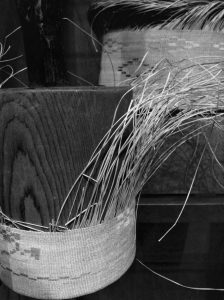An Artifact: chivtux “grass basket”
“The grass proved difficult to work with, but the weavers persisted” (1).
chivtux “grass basket”
Language: Unangam Tunuu (Attuan dialect)
Courtesy of: Alaska State Museum – Juneau
I cannot peel my eyes away from the Aluet Basketry collection at the Alaska State Museum. One basket that particularly stands out is a hand woven grass basket in the Attu style. There are three distinct types of Aleut Basketry that come from Atka Island, Unalaska Island and Attu Island.
The basket that catches my eye is not finished; strands of the most delicate grass splay in all directions and I cannot stop thinking about the woman who took the time to weave 1050 stitches per square inch. Each blade of grass for this basket was gathered in the summer on coastal hillsides; not too close to the the ocean or it would be too coarse and not too far away or the grass would be too brittle. The weaver then bundles, ages, and sorts each individual strand, before drying and splitting every blade of grass with a fingernail or needle. Before weaving, the grasses are often coloured with berries, tea, clay, coffee, and even onion skins for yellow (2).

As shown in the picture from the Alaska State Library Archives, Attu baskets are held upside down during the weaving process. The weaving is done from left to right while the basket is rotated clockwise.
Attu weavers maintain a strong tension with each strand of grass to create a finer weave than other Aleut styles. In fact many Attu baskets are so tightly woven that they are able to carry water. I am drawn to so much more than just the dexterity of the stitches, and the detail of the patterns. These baskets are representative of the spirituality, and the interwoven history. They exist, like all the art I see in the Alaska State Museum, because of the artists’ perseverance.
They persisted in the 1800s when Russians entered the Aleutians with force and brutality. They persisted in the 1900s when they watched the U.S. military burn their entire village to the ground, including the cured grass that the women had prepared all summer. During WW II Attuans were forcefully relocated to an abandoned herring factory, with poor water supply, little housing and no access to subsistence hunting and fishing. Within days of arrival these determined artists began collecting grass, similar to the grass that grew in on Attu Island, and they began weaving.

Weaving is a deeply embedded part of life for the Attuan people. Babies sleep in woven cradles, and warriors wore woven belts that offered protection. Women wove clothing, mats, bedding and even sheets to separate rooms in their homes. Even the sun sleeps on a grass mat, while the moon (an important uncle) travels across the night sky.
Sources:

This really caught my eye as well, Heidi. The forced relocation of Aleuts to Southeast Alaska during WWII is a remarkably sad part of Alaskan history. The Attuan basketmakers’ ability to keep their traditions alive in spite of their immense suffering in a radically different environment is a testament to the strength of their culture and their resiliency as a people. Thanks for choosing this artifact.
Heidi,
I appreciate how you chose an unfinished basket as the one to use in this post-it displays characteristics of patience and strength while valuing skills in dexterity. The strands of grass look frazzled until they meet the end of the basket where they meet the beautiful craft. Baskets are a deeply embedded value to the indigenous people. Like the people who made them, they have survived for thousands of years. Great job!
-Lindsay
Heidi, I love the photo and quote you chose to lead with on this post. What a beautiful and simple demonstration of resiliency of a people and their culture.
Great writing, Heidi. This was awesome to read. I missed the Attu baskets (or didn’t remember them), and this really was a great immersion. I find it really fascinating you went further and researched the baskets in the archives, too.
What a beautiful post! It’s mind-boggling to look at that unfinished basket and realize that the tight, intricate weaving at the bottom started out as those dry strands of grass at the top. I love that you used this image to tell us so much about Aleut history and culture.